
* The Soviet Union had a certain admiration for the virtue of sheer impressive size, and this bias was reflected in aircraft design. The most spectacular examples are three of the largest aircraft ever built, all products of the Antonov design bureau: the "An-22 Antheus (Cock)", the "An-124 Ruslan (Condor)", and the "An-225 Mriya (Cossack)" cargolifters. This document provides a history and description of these Antonov giants. A list of illustration credits is given at the end.
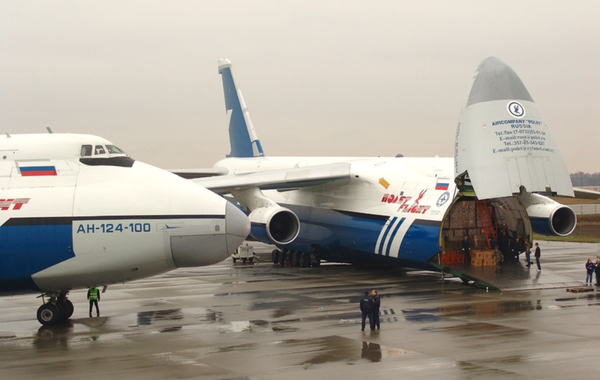
* On 16 June 1965, the Soviet Union impressed Western observers by flying in a prototype of a new cargolifter aircraft, the Antonov "An-22 Antel (Antheus)", to the Paris Air Show. The new transport was indisputably the biggest aircraft in the world; NATO assigned it the reporting name of "Cock". The An-22 had performed its first flight only months before, on 27 February 1965. By 1967, the initial prototype that made its debut in Paris had been followed by two more prototypes and the first production item. The Soviets were proud of their impressive big machine, demonstrating it in public air displays in the USSR and announcing that it had set a number of payload-to-height records.
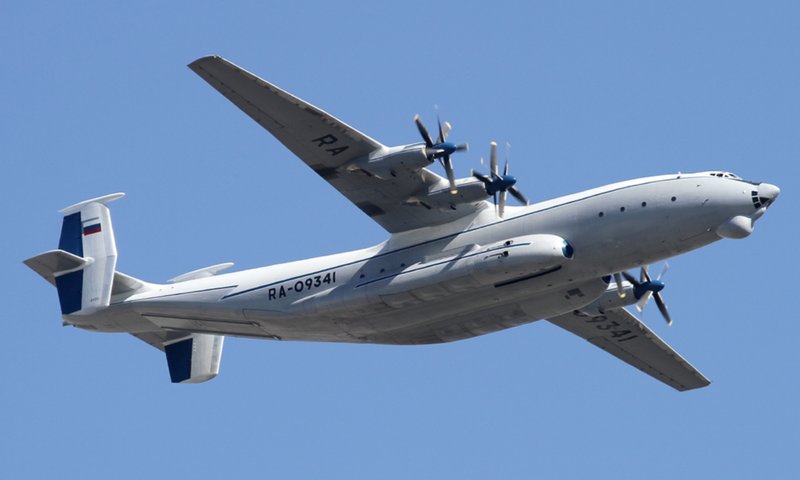
Observers recognized that the new machine was clearly a scaled up An-12 "Cub", both machines being four-engine turboprops with a high-mounted, straight, narrow-chord wing. Both aircraft also featured main landing gear mounted in fairings along the fuselage, with a pressurized crew compartment and unpressurized cargo compartment. There were also clear differences between the two, beyond their difference in size. Unlike the An-12, the An-22 used four-bladed contrarotating propellers, driven by Kuznetsov NK-12MA turboprop engines providing a staggering 11.2 kW (15,000 SHP) each. The An-22 also featured twin tailfins, instead of the An-12's large single tailfin. The twin tailfins gave the An-22 better handling with an engine out, and a single tailfin would have had to have been much too tall anyway.
The narrow-chord wing of the An-22 meant that the total wing area was low, making the wing loading was unusually high for a cargolifter, but the wing had double slotted flaps over 60% of its length, and the An-22 could take off in 1,400 meters (4,265 feet) in fully-loaded condition. The An-22 was designed for rough-field operation, with two-wheel nosegear and three levered-suspension dual main landing gear assemblies in each fairing, for a total of six main gear assemblies and twelve main gear wheels. The aircrew could adjust tire pressure from the cockpit to compensate for field conditions.
There were five or six crew, plus a pressurized compartment behind the cockpit with seating for 28 or 29 passengers. Personnel access was through a door in each landing gear fairing. The main cargo bay was 33 meters (108 feet) long, and was accessed through a rear loading ramp. The ramp could be opened in flight for cargo airdrop. Cargo capacity was 80 tonnes (88 tons). There were four traveling gantries mounted on rails in the roof of the cargo bay, to be used in conjunction with two winches, each with a load capacity of 2,500 kilograms (5,500 pounds).
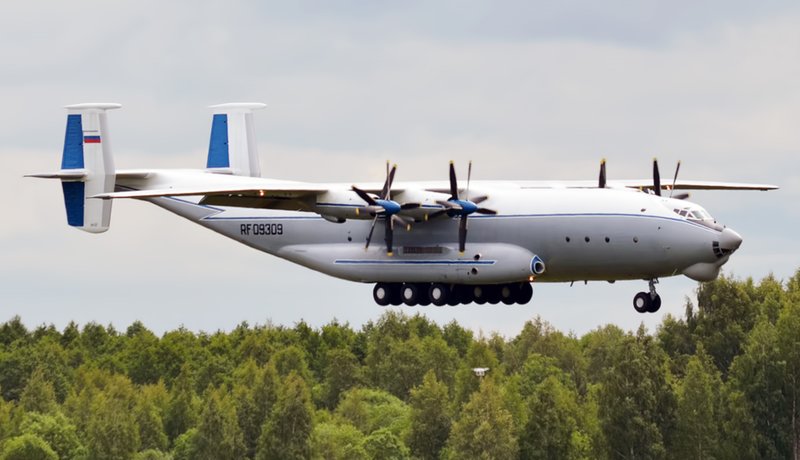
An array of three radars were fitted, with radomes under the nose, for navigation and weather warning; and like most Soviet transports of the era, there was glazing under the nose for the navigator.
___________________________________________________________________
ANTONOV AN-22 ANTHEUS ("COCK"):
___________________________________________________________________
wingspan:
64.40 meters (211 feet 3 inches)
wing area:
345 sq_meters (3,714 sq_feet)
length:
57.9 meters (190 feet)
height:
12.53 meters (41 feet 1 inch)
empty weight:
114,000 kilograms (251,325 pounds)
max take-off weight:
250,000 kilograms (551,155 pounds)
max speed at altitude:
740 KPH (460 MPH / 400 KT)
service ceiling:
7,500 meters (24,600 feet)
range, max payload:
5,000 kilometers (3,100 MI / 2,700 NMI)
range, max fuel:
10,950 kilometers (6,800 MI / 5,920 NMI)
___________________________________________________________________
The initial production version of the An-22 required ground-starting equipment; 37 were built, followed by 28 "An-22A" machines, with a self-starting capability and improved avionics. It appears an auxiliary power unit (APU) was installed in each of the main landing gear sponsons, at least suggested by an intake hole in the front and two exhaust holes on the sides. It is not clear if the APUs were fitted to the early production machines.
Of the 65 production machines produced to end of manufacture in 1974, the totals were split evenly between Aeroflot and the VTA, the Soviet military airlift service, though some sources claim that even the Aeroflot machines were generally used for military duties. Some of the five prototypes were upgraded to production specification and put into formal service. The An-22s were used mostly to carry cargoes to the undeveloped Soviet Far East. The Antonov bureau considered building a double-decker airliner version of the An-22, with a capacity of 724 passengers, but this machine never got beyond design studies.
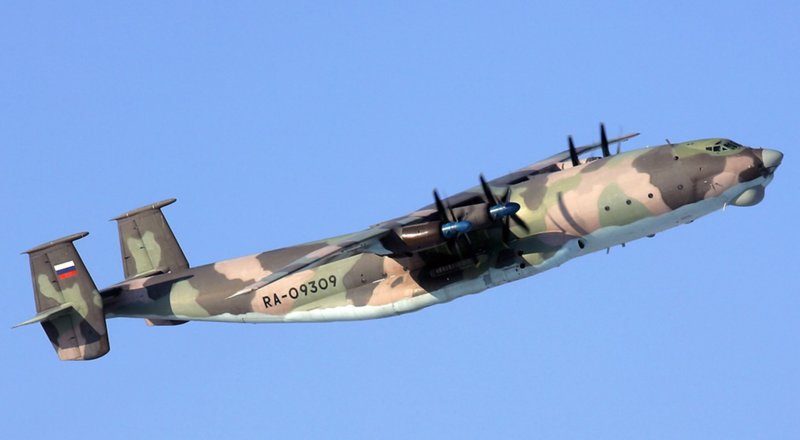
The An-22 was supplemented by the Antonov An-124, discussed below, beginning in 1987. An-22s, being still useful for hauling heavy loads, have been refurbished to be kept in service -- with Antonov converting two of them to "An-22PZ" configuration to haul large aircraft assemblies for Antonov production. One An-22 crashed during Russian military exercises in 2010, killing all 12 crew. Other An-22s were grounded until the problem was tracked down. One overhauled machine was in commercial service with Antonov Airlines; it is somewhat doubtful that any An-22s are still flying.
BACK_TO_TOP* In 1968, the US flew the first Lockheed "C-5A Galaxy" cargolifter, which took the title of "world's biggest aircraft" away from the An-22. The USSR was of course inclined to respond -- to the extent that need justified it and the resources were available -- and in the summer of 1977, reports indicated that the Soviets were in fact working on a mega-sized jet cargolifter.
The initial prototype of the new aircraft performed its first flight on 24 December 1982, with Antonov test pilot Vladimir Tersky as captain. The first production aircraft performed its first flight in December 1984. Although the NATO rumor mill had assigned the type the designation "An-40" and then "An-400", along with the NATO reporting name "Condor", in 1985 the big jet was announced as the "An-124 Ruslan". The aircraft entered service in early 1986. Production was from two plants, one in Kiev, the other in Ulyanosk.
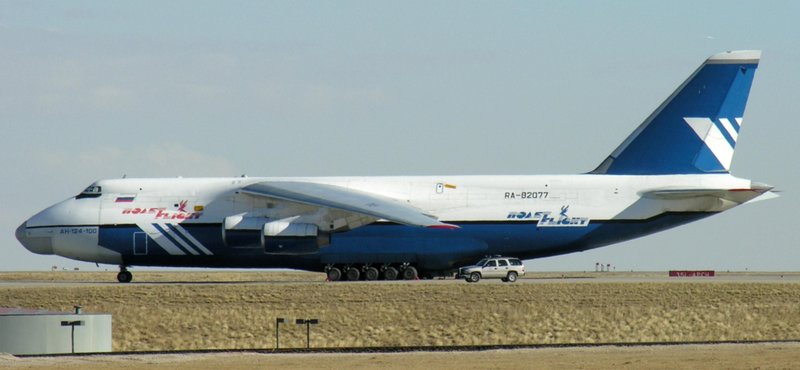
The An-124 had a general configuration similar to that of the C-5A, with a high-set swept wing mounting four high-bypass turbofans on pylons, the aircraft featuring front and rear loading. The most significant visible difference from the C-5A was that the An-124 had a conventional low-set tailplane, in contrast to the tee tail of the C-5A. Although the dimensions of the two aircraft were similar, the An-124 had a greater empty weight than the C-5A and substantially greater cargo capacity.
The An-124 had very heavy-duty landing gear for rough field operation. The nose gear consisted of two twin-wheel units mounted in parallel, with each unit steered independently. There were five sets of main landing gear units on each side of the aircraft, with dual wheels on each set, for a total of ten sets and twenty wheels. The front two units on each side were steerable. The landing gear was adjustable to allow the transport to "kneel", to assist cargo loading.
The An-124's four Lotarev D-18T turbofans provided 230 kN (23,400 kgp / 51,590 lbf) thrust each, and had thrust reversers to reduce landing roll. In conjunction with full-span leading-edge slats and large flaps, the powerful engines allowed the An-124 to operate off of rough airstrips only 1,200 meters (3,800 feet) long. Unfortunately, the D-18Ts had low reliability early on, and only gradually improved.
___________________________________________________________________
ANTONOV AN-124 RUSLAN ("CONDOR"):
___________________________________________________________________
wingspan 73.3 meters (240 feet 6 inches)
wing area 628 sq_meters (6,760 sq_feet)
length 69.1 meters (226 feet 8 inches)
height 20.78 meters (68 feet 2 inches)
empty weight 175,000 kilograms (385,800 pounds)
loaded weight 405,000 kilograms (832,875 pounds)
max speed at altitude 865 KPH (535 MPH / 465 KT)
cruising altitude 10,000 meters (33,000 feet)
range, max payload 4,500 kilometers (2,795 MI / 2,430 NMI)
range, max fuel 16,500 kilometers (10,250 MI / 8,920 NMI)
___________________________________________________________________
The pressurized cabin accommodated a flight crew of six, along with accommodations for a relief crew. The aircraft featured leading-edge avionics being flown with a quadruplex fly-by-wire flight control system, and featuring a triple-redundant inertial navigation system. It did not have a glazed nose. A pressurized passenger section with 88 seats was included behind the wing.

The transport's nose lifted up to allow a fold-out loading ramp to be deployed, while the tail featured a four-section door-ramp system. The cargo hold was 26 meters (118 feet) long, 6.4 meters (21 feet) wide, and 4.4 meters (14 feet 5 inches) high. Two traveling gantries were fitted to the roof, with each gantry having a load capacity of 10,000 kilograms (22,050 pounds) and fitted with two hoists, each having a load capacity of 5,000 kilograms (11,025 pounds). Twin APUs could be used to power the hoist system on the ground. The aircraft could carry a load of up to 150 tonnes (165 tons).
* A total of 54 Condors was built up to 2004, the aircraft being roughly split between civil and military users. Interestingly, two An-22s were modified to carry the wings on their back for assembly. The Russian Aerospace Force currently has 26 An-124s in service. Since 2010, 14 of them have been upgraded with features such as a modernized cockpit -- reducing cockpit crew from 6 to 4 -- plus other updated avionics; much more reliable D-18T turbofans that meet international noise and emissions regulations; and a service-life extension program (SLEP) that provided a number of airframe and systems improvements.
A total of 20 "An-124-100" civil machines ended up in service with three operators:
A number of civil An-124s was upgraded to "An-124-100M" standard -- just like the upgraded military An-124s, with a modernized cockpit, improved turbofans, and a SLEP.
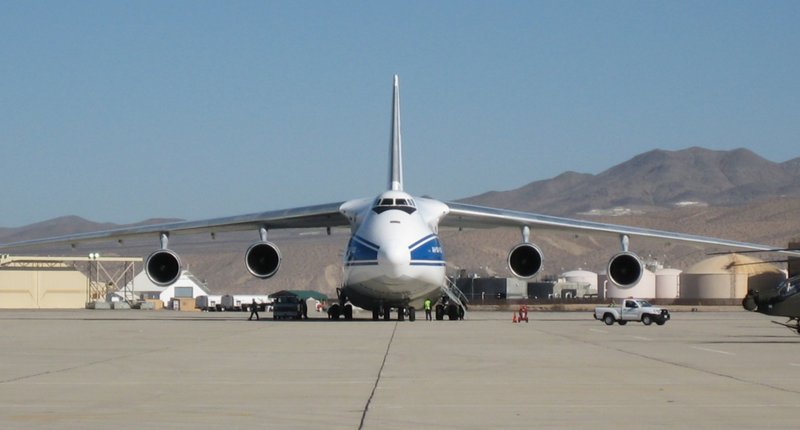
The An-124 remains a product with a unique niche, being used to haul heavy equipment all over the world, and it has played a major role in United Nations operations in countries such as Afghanistan. There has been talk of new production, but it disappeared in 2022 when Russia invaded Ukraine. Ukrainian An-124s fly out of Leipzig, Germany, where they relocated after the invasion. In accordance with sanctions on Russia, Germany impounded three Volga-Dnepr An-124s while Canada impounded one, with protracted legal action following to confiscate it -- presumably to be handed over to Ukraine.
BACK_TO_TOP* Even as the An-124 was going into service, the Antonov bureau was working on a specialized derivative to carry outsize cargoes, usually externally. The primary loads were intended to be elements of the Soviet "Energia" heavy-lift space booster series, including the "Buran" manned space shuttle.
The result, the "An-225 Mriya (Dream)" performed its first flight on 21 December 1988, with Alexander Galunenko at the controls. It appeared at the Paris Air Show in 1989 with a Buran shuttle on its back. It was assigned the NATO reporting name of "Cossack". The An-225 was clearly a derivative of the An-124, with fore and aft fuselage plugs to extend length, and wing inserts to extend span and allow mount of two more Lotarev D-18T turbofans, for a total of six engines.
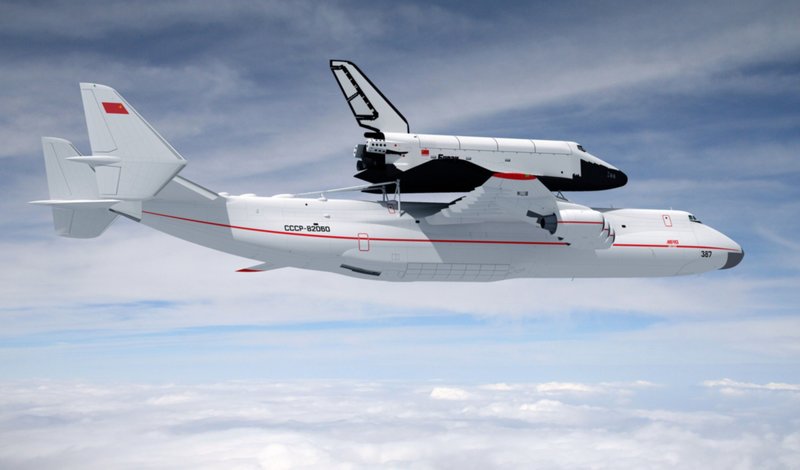
The number of main landing gear assemblies was increased from five per side to seven to handle the increased take-off weight. A set of standoffs was fitted to the back for external cargo carriage, with the standoffs covered by fairings when not in use, and the conventional tail assembly of the An-124 was changed to a twin-fin assembly to ensure controllability when a large cargo was mounted on the back. The rear loading ramp was deleted to reduce weight.
The An-225 could lift cargoes with a weight of up to 250 tonnes (275 tons). Since it was not intended for any tactical role, it was not designed for short-field operation, and had a take-off length of 3,500 meters (11,500 feet) with maximum payload.
___________________________________________________________________
ANTONOV AN-225 MRIYA ("COSSACK"):
___________________________________________________________________
wingspan:
88.4 meters (290 feet)
wing area:
905 sq_meters (9,742 sq_feet)
length:
84 meters (275 feet 7 inches)
height:
18.2 meters (59 feet 9 inches)
empty weight:
175,000 kilograms (385,800 pounds)
max take-off weight:
600,000 kilograms (1,322,275 pounds)
max speed at altitude:
850 KPH (530 MPH / 460 KT)
cruising altitude:
10,000 meters (33,000 feet)
range, max payload:
4,500 kilometers (2,795 MI / 2,430 NMI)
range, max fuel:
15,400 kilometers (9,570 MI / 8,310 NMI)
___________________________________________________________________
The An-225 was the world's biggest aircraft by far. Since it was a specialized machine, it is unlikely that there would have been reason to build it in large numbers in the best of circumstances. Given that the introduction of the big cargolifter coincided with the last days of the Soviet Union, it is not surprising that only one was built -- and it was mothballed in 1994, being used as a spares hulk for An-124s. A second machine was not completed.
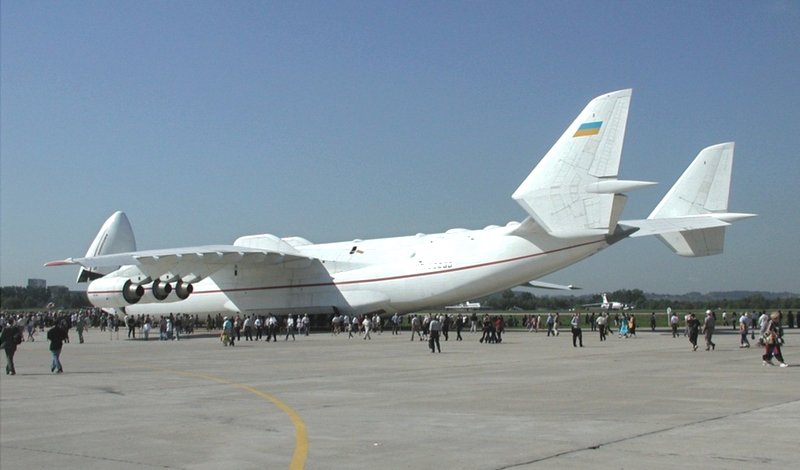
However, since the An-124 proved profitable in the commercial heavy-lift market, the An-225 was pulled out of mothballs and put to work. The Antonov bureau refurbished the An-225s for commercial operations, including transport of bulky cargoes and possibly air launch of space boosters. The program involved the addition of modern navigation and communication avionics, a collision avoidance system, and modifications to reduce the noise signature of the aircraft. First flight of the revitalized An-225 was on 7 May 2001. The An-225 was well more expensive to operate than the An-124, and so had a low utilization rate -- being only flown with cargoes that couldn't be hauled any other way. It was destroyed when the Russians invaded Ukraine in early 2022. Apparently, assemblies were built for the second machine, and there's talk of getting it flying, should the war ever permit it.
The Antonov organization has also investigated a more ambitious cargolifter, an improved hybrid of the An-124 and An-225 called the "An-124-300". It would feature the fuselage of the An-124 and the extended wing of the An-225, kitted up with modern avionics and engines. Since more powerful engines have been developed, only four would be needed instead of six. The cargo floor would be extended, and a palletized loading system would be installed. It would have a maximum range of 11,500 kilometers (7,145 miles) with a 100-tonne (110-ton) cargo.
With all connections between Ukraine and Russia having been broken, the Antonov organization has been interested in "Westernizing" the An-124 and any follow-ons -- using Western avionics and systems, and possibly re-engining the aircraft with Western turbofans. However, Ukraine's preoccupation with evicting the Russian invaders means that won't happen for some time.
The Russians considered their own alternative to the An-124, the "PAK VTA" or "Ilyushin Il-106", with images of wind-tunnel models released in 2020. The Il-106 was seen as a "blended wing-body" aircraft, able to haul up to 180 tonnes of cargo, 60 tonnes more than the An-124, and have a range of 7000 kilometers (4,350 miles), a maximum speed of 850 KPH (525 MPH), and be powered by four Aviadvigatel PD-35 turbofans -- the PD-35 being an improved derivative of the new PD-14 engine. However, the invasion of Ukraine ended up disastrously destabilizing the Russian state, so all plans for aircraft development are up in the air for now.
BACK_TO_TOP* Much to my surprise, I saw an An-124 in the late 1990s while I was flying to Florida, making a Houston stopover. I saw this huge aircraft sitting alongside the runway and thought: "What the HELL is that monster?" As it turned out, apparently the Russians had a regular arrangement with some Texas oil companies and used the An-124 to transfer oil drilling gear to the various former-Soviet Central Asian republics. I had to admit the thing was impressive.
A few years later I got an email from a US Army sort who told me a story about how an An-124 flew into Wichita, Kansas, with some heavy industrial machinery from Switzerland for the Boeing plant there. All things considered, it was the cheapest way to deliver the machinery. On departure, the An-124 lost an engine, and was grounded for four days while a spare engine was delivered and installed. My correspondent concluded: "The folks at the modifications hangars weren't sure whether to be impressed or horrified at this feat of repair."
I replied: "That almost might be a broad comment on Russian technology in general." He added that the Russians bitterly complained about the poor quality of American vodka, and that half a case of Russian vodka was provided as part of the repair kit. That made me imagine a conversation: "What's Kansas like, Dmitriy Mikhailovich?"
"Much like Ukraine, Ivan Borisovich, but the vodka is lousy."

Just before Christmas 2005, I spotted an An-124 in what amounted to my own backyard, parked on the tarmac at Denver International Airport. Obviously, the thing wasn't there to deliver holiday parcels; a search on the Web said that An-124s periodically flew into Denver to transport space-launch boosters to Cape Canaveral from the Lockheed Martin plant south of Denver. I believe these are Atlas boosters -- using Russian-designed main engines. Times had changed, though since then, they have badly regressed again.
* Sources include:
* Illustration credits:
* Revision history:
v1.0.0 / 01 dec 02 v1.0.1 / 01 mar 03 / Typo corrections. v1.0.2 / 01 mar 05 / Review & polish. v1.0.3 / 01 jan 06 / Review & polish. v1.0.4 / 01 dec 07 / Review & polish. v1.0.5 / 01 nov 09 / Review & polish. v1.0.6 / 01 oct 11 / Review & polish. v1.0.7 / 01 sep 13 / Review & polish. v1.0.8 / 01 aug 15 / An-124 production restart. v1.0.9 / 01 jul 17 / Review & polish. v1.1.0 / 01 jun 19 / General cleanup. v1.1.1 / 01 may 21 / Il-106 comments. v1.2.0 / 01 apr 23 / Il-106 comments. v1.2.1 / 01 mar 23 / Review & polish. (++)BACK_TO_TOP
